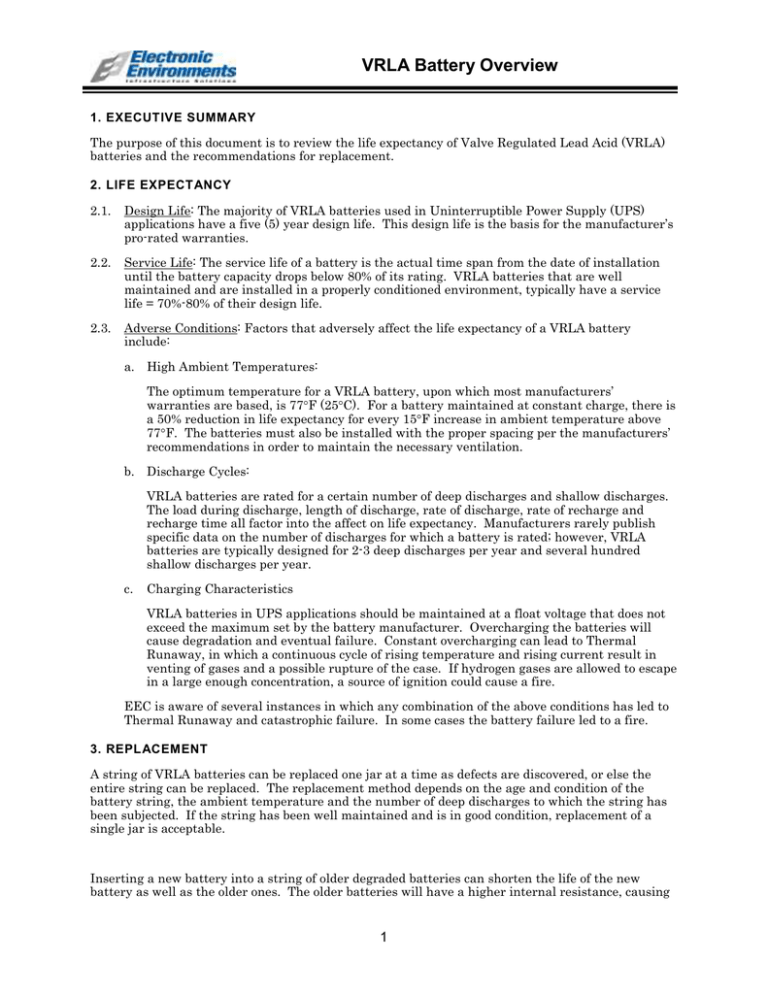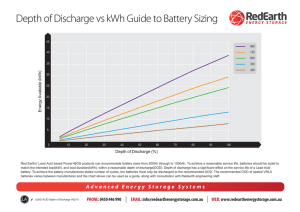VRLA Battery Expected Life Span and Replacement Options
advertisement

VRLA Battery Overview 1. EXECUTIVE SUMMARY The purpose of this document is to review the life expectancy of Valve Regulated Lead Acid (VRLA) batteries and the recommendations for replacement. 2. LIFE EXPECTANCY 2.1. Design Life: The majority of VRLA batteries used in Uninterruptible Power Supply (UPS) applications have a five (5) year design life. This design life is the basis for the manufacturer’s pro-rated warranties. 2.2. Service Life: The service life of a battery is the actual time span from the date of installation until the battery capacity drops below 80% of its rating. VRLA batteries that are well maintained and are installed in a properly conditioned environment, typically have a service life = 70%-80% of their design life. 2.3. Adverse Conditions: Factors that adversely affect the life expectancy of a VRLA battery include: a. High Ambient Temperatures: The optimum temperature for a VRLA battery, upon which most manufacturers’ warranties are based, is 77°F (25°C). For a battery maintained at constant charge, there is a 50% reduction in life expectancy for every 15°F increase in ambient temperature above 77°F. The batteries must also be installed with the proper spacing per the manufacturers’ recommendations in order to maintain the necessary ventilation. b. Discharge Cycles: VRLA batteries are rated for a certain number of deep discharges and shallow discharges. The load during discharge, length of discharge, rate of discharge, rate of recharge and recharge time all factor into the affect on life expectancy. Manufacturers rarely publish specific data on the number of discharges for which a battery is rated; however, VRLA batteries are typically designed for 2-3 deep discharges per year and several hundred shallow discharges per year. c. Charging Characteristics VRLA batteries in UPS applications should be maintained at a float voltage that does not exceed the maximum set by the battery manufacturer. Overcharging the batteries will cause degradation and eventual failure. Constant overcharging can lead to Thermal Runaway, in which a continuous cycle of rising temperature and rising current result in venting of gases and a possible rupture of the case. If hydrogen gases are allowed to escape in a large enough concentration, a source of ignition could cause a fire. EEC is aware of several instances in which any combination of the above conditions has led to Thermal Runaway and catastrophic failure. In some cases the battery failure led to a fire. 3. REPLACEMENT A string of VRLA batteries can be replaced one jar at a time as defects are discovered, or else the entire string can be replaced. The replacement method depends on the age and condition of the battery string, the ambient temperature and the number of deep discharges to which the string has been subjected. If the string has been well maintained and is in good condition, replacement of a single jar is acceptable. Inserting a new battery into a string of older degraded batteries can shorten the life of the new battery as well as the older ones. The older batteries will have a higher internal resistance, causing 1 VRLA Battery Overview them to recharge to a high voltage level. The new battery on the other hand, has a lower internal resistance and will recharge to a lower voltage. The end result will be a prematurely aging battery string. 4. REFERENCES 4.1. American Power Conversion, “Battery Technology for Data Centers and Network Rooms: VRLA Reliability and Safety”, Rev 2002-1. 4.2. Powerware Corporation, “Knowledge Base - Batteries”, 1999-2004. 2


